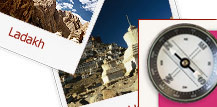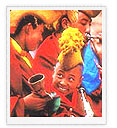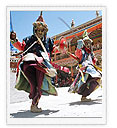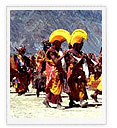

  |
|
| Ladakh TrekkkingToursLadakh TourismMonasteries FestivalsTrekking Adventure & ToursHotels in Ladakh |
     |
Ladakh Trekking Tours :: Festivals in LadakhFestivals in LadakhFestivals in Ladakh are famous as the occasions for merry-making. These festivals give people with ample opportunities to intermingle with each other, structure new ties and replenish the old ones. Many of the yearly festivals of the Gompas take place in winter, which is a fairly idle time for majority of the people. These take the form of dance-dramas in the gompa courtyards. Lamas, attired in colourful robes and wearing masks, perform mimes symbolising a range of aspects of the religion such as the advancement of the entity soul and its decontamination or the triumph of good over evil. Local people flock from near and far to these events and the spiritual benefits they get are no doubt finely tuned by their pleasure of the party atmosphere. Ladakh Festivals Dates:
Hemis Festival, LadakhLadakh is a depot of culture and adventure. The Buddhist culture in Ladakh has been inviting travellers for ages from all parts of the world. Fairs and festivals of Ladakh are a perfect mirror to the cultural practices and traditions that carry on in Ladakh. The Hemis Festival of Ladakh is a major crowd puller and holds a lot of significance in terms of culture. The festival, which runs for two days, is celebrated to mark the birth anniversary of the Buddhist guru Padmasambhava. The festivities of Hemis take place at the world-famous Hemis Gompa, located at a distance of 45 km from the capital town of Leh.The two-day-long festival falls on the 10th day of the Tibetan Lunar month. According to Georgian calendar, it is the time during June and July. Sacred dances, contradictory explanations and special musical performances are the major highlights of the Hemis Festival in Ladakh. During the festival, lamas and monks gather at the Hemis Gompa to perform the sacred Mask Dance. The specific dance form is meant to celebrate good over evil. Apart from these dances, the lamas also come up to explain the significance and the actual meaning of the sacred dance performances. The Hemis Festival brings an opportunity for all the villagers and families to come together and socialise. Men can be seen wearing cummerbands while women are dressed in bright headgear and lots of jewellery. Brass trumpets, which are 3 metre in length, are played and the whole festive scene becomes a sight to behold. Travellers also stand good chances of interacting with rural people which is otherwise not possible. The Hemis Gompa becomes a hub of celebratory activities during the festival. The gompa, which is known to be the wealthiest and the biggest in Ladakh, also features the largest thangka in Ladakh. The Buddhist gompa remains divided into two main parts - the assembly hall on the right and the temple on the left. During the Hemis celebrations, the hall Dukhang becomes the greenroom of the dancers. The temple is locally known as Tshogkhang. A colourful fair is also organised during the Hemis Festival and serves as a major attraction for tourists as well as locals. A range of handicrafts are put on sale during the exhibition and you can always find some wonderful souvenirs to take back home. There are a number of other Buddhist festivals in Ladakh for you to join in. Each one of these has a special significance and has its own festive highlights. Dosmoche - Festival in LadakhDosmoche, the festival of the scapegoat, is celebrated with fervor at Leh. Falling in the second half of February, Dosmoche is one of two New Year festivals, the other being Losar. At Dosmoche, a great wooden mast decorated with streamers and religious emblems is et up outside Leh. At the appointed time, offerings of storma, ritual figures moulded out of dough, are brought out and ceremonially cast away into the desert, or burnt. These scapegoats carry away with them the evil spirits of the old year, and thus the town is cleansed and made ready to welcome the new year. Spituk, stok, thikse, chemrey and Matho all have their festivals in winter, between November and March. Likir and Deskit (Nubra )time their festivals to coincide with Dosmoche.Losar- Festival in LadakhLosar -this spectacular festival celebrates the Ladakhi/Tibetan new year. Festivities last for 2 weeks during December or January,depending on the Lunar calander . All Ladakhi Buddhists celebrate it by making offerings to the gods, both in gompas and in their domestic shrines. The festival is marked with ancient rituals,the stage fights between good & evil, chanting and passing through the crowds with fire torches. The dance of the Ibex deer and the dramatic battles between the King & his ministers add to the joyous atmosphere. Full of music,dancing and merry-making ! This important festival changes location & dates every year.Sindhu Darshan - Festival in LadakhSindhu Darshan Festival, as the name suggests, is a celebration of river Sindhu, also known as the Indus. People travel for a Darshan and Puja of the River Sindhu (Indus) which originates from the Mansarovar in Tibet. The Festival aims at projecting the Sindhu river as a symbol of multi-dimensional cultural identity, communal harmony and peaceful co-existence in India. Whilst promoting tourism in this area, this festival is also a symbolic salute to the brave soldiers of India who have valiantly fought the odds at Siachen, Kargil and other places.It is also an opportunity for people from around the country and overseas to visit the beautiful regions of Leh and Ladakh. Celebrated first time in the year 1997, the festival is organised annually at Leh in the month of May-June by the Government of Jammu and Kashmir with the support of the Ministry of tourism and culture, Government of India. The festival is kaleidoscope of Indian culture and showcases an exciting array of performing arts being brought together at an exciting place. As part of the celebrations, various groups from different states in India bring water from the other mighty rivers in the country in earthen pots and immerse these pots in the Sindhu river, thereby mingling the river water with other waters of the land. Ladakh Harvest FestivalThe festival usually starts from 1st september and lasts till sepftember 15th. It is a colourful celebration of the rich,cultural diversity of Ladakh's people. The weeks long festivities are held all over the region. Music, theatre, polo, archery,& wedding ceremonies,are performed daily along with mask and folk dances,with the final carnival parade passing through the streets of Leh.Ladakh Festivalsis the blend of various cultures of Central Asian, Tibetan, Northern India are found in Ladakh. The span of Ladakh festival is of 15 days i.e From the 1st to the 15th of September. Various sports such as polo and archery are conducted. Folk dances and songs, its age-old social And cultural ceremonies, its art and handicrafts, all come alive in a colorful kaleidoscope.
Tak-Tok festival is celebrated at cave Gompa of Tak- Tok . It is among the major festivals of Ladakh. Celebrated in summer, it is yet another tourist attraction. The festival is celebrated with fanfare and locals from far-flung areas storm the place on the occasion. |